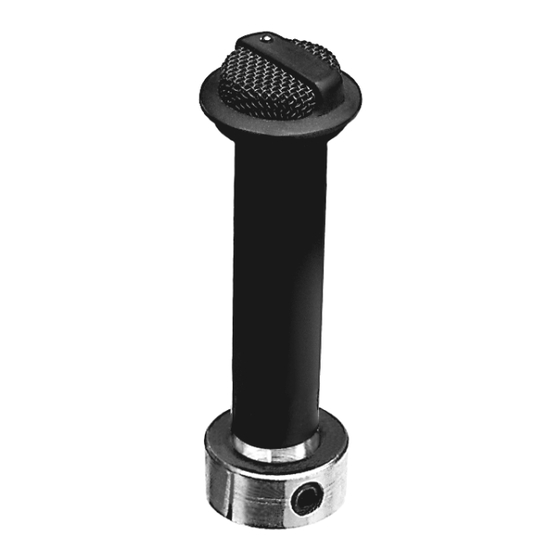
Crown MINI-BOUNDARY MB-3 Quick Start Manual
Hide thumbs
Also See for MINI-BOUNDARY MB-3:
- Datasheet (2 pages) ,
- Application manual (8 pages) ,
- Application manual (5 pages)
Advertisement
MB-3
T
he Crown
®
MB-3 is a miniature boundary
microphone for multi-miking applications
such as teleconferencing, distance learn-
ing, boardrooms, courtrooms, and security
applications. This low-profile, circular mic
permanently installs into a hole drilled in a
table, lectern, or ceiling.
Thanks to its supercardioid pickup pattern, the
MB-3 greatly reduces ambient noise and
pickup of room reverberation. The result is a
clearer, more intelligible sound.
On the bottom of the mic is a tubular power
module with a 3-pin XLR-type output connec-
tor. It is powered by 12-48V phantom power,
and has a low-impedance balanced mic-level
output.
Features
• Small, inconspicuous.
• Installs permanently in table top, wall or
ceiling.
• Clean, clear, natural sound.
• Low-Z balanced mic-level output prevents
hum and high-frequency loss.
• Removable grille assembly can be painted.
How to Paint the Microphone
1. Using a small screwdriver, pry open one side
of the base, then the other side (Fig. 5).
2. Remove the foam liner.
3. Wearing a dust mask, spray-paint the grille
assembly. Be sure grille holes are not clogged.
4. Allow to completely dry.
5. Make sure the LED is properly aligned.
6. Carefully place the grille assembly over the
base, and snap in place.
Installation
Tables: In a table, typical placement for each
mic is an arm's length from the user. Install
one microphone in front of each person, or one
between every two people.
Lecterns: If the microphone will be used on a
lectern, install it on an open surface. Do not
install in a cavity or recessed area as the fre-
quency response and polar pattern will be
degraded.
Ceilings: When mounting mics in the ceiling,
use as few mics as possible, and put them in
front of the people speaking—not directly
overhead.
Note: The system gain-before-feedback may
not be adequate in ceiling mount applications
because the mic is far from its user.
™
MINI-BOUNDARY
MICROPHONE
Specifications
Type: Phase Coherent Cardioid.
Element: Electret condenser.
Frequency response (typical): 50 Hz to 15,000 Hz at
30 degrees incidence to surface (see Fig. 1).
Polar pattern: Half-supercardioid (supercardioid in
the hemisphere above the primary boundary). See
Figs. 2 and 3.
Impedance: 150 ohms, balanced (recommended
load impedance 1000 ohms or greater).
Open-circuit sensitivity (typical): 22 mV/Pa* (–33
dB re 1 volt/Pa).
Power sensitivity: –30.5 dB re 1 mW/Pa*. EIA rating
–125 dBm.
Equivalent noise level (self-noise): 22 dB SPL
typical (0 dB=0.0002 dyne/cm
2
), A-weighted.
S/N ratio: 72 dB at 94 dB SPL.
Maximum SPL: 120 dB SPL at 3% THD.
Polarity: Positive (inward) pressure on the
diaphragm produces positive voltage on pin 2
with respect to pin 3.
Operating voltage: Phantom power, 12-48 volts DC
on pins 2 and 3 with respect to pin 1 of output
connector.
Current drain: 4 mA nominal.
Connector: 3-pin pro audio, XLR-M type.
Cable: None supplied. Use two-conductor shielded
mic cable.
Materials: High-impact molded plastic and steel
mesh mic grille, steel chassis.
Finish: Satin black.
Net weight: 2.7 ounces (78 grams).
Dimensions: See Fig. 4.
Optional accessories: PH-1A phantom power
supply (1 channel, battery or DC-adapter
powered). PH-4A phantom power supply (4
channels, AC powered).
*1 pascal = 10 dynes/cm
2
= 10 microbars = 94 dB SPL.
Fig. 1
Frequency Response
+15
+10
+5
dB 0
–5
–10
–15
–20
–25
–30
–35
20
100
Frequency in Hz
Fig. 2
Horizontal-Plane Polar Response
330˚
300˚
270˚
240˚
210˚
Fig. 3
Vertical-Plane Polar Response
60˚
30˚
www.audiovias.com
FRONT
0˚
+
5
–0
–5
–10
–15
–
0˚
130˚
10K
1K
0˚
30˚
FRONT
–0
60˚
–5
–10
–15
–20
90˚
120˚
1 kHz
200 Hz
5 kHz
REAR
180˚
150˚
90˚
120˚
1 kHz
200 Hz
5 kHz
150˚
REAR
180˚
20
Advertisement
Table of Contents

Summary of Contents for Crown MINI-BOUNDARY MB-3
- Page 1 ™ MINI-BOUNDARY MICROPHONE MB-3 he Crown ® MB-3 is a miniature boundary microphone for multi-miking applications such as teleconferencing, distance learn- ing, boardrooms, courtrooms, and security applications. This low-profile, circular mic permanently installs into a hole drilled in a table, lectern, or ceiling.
- Page 2 If there the mic so the word “Crown” is readable by the coherency achieved by mounting a small- is hum or no signal, first repair or replace the user.










Need help?
Do you have a question about the MINI-BOUNDARY MB-3 and is the answer not in the manual?
Questions and answers